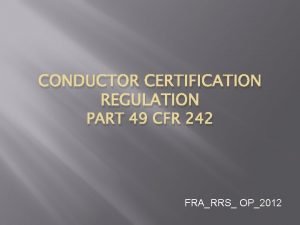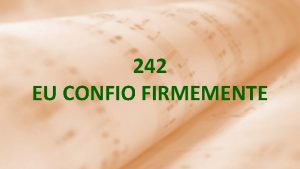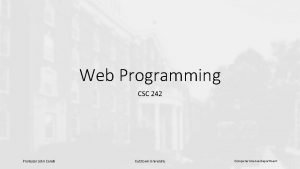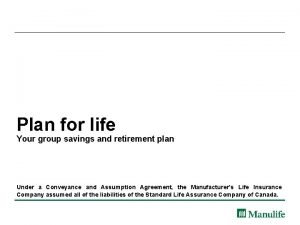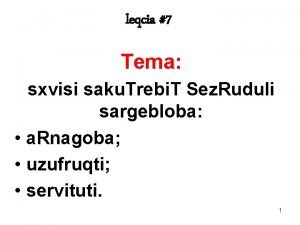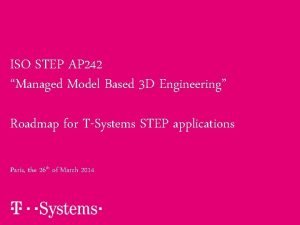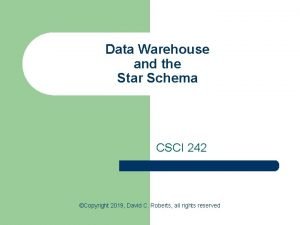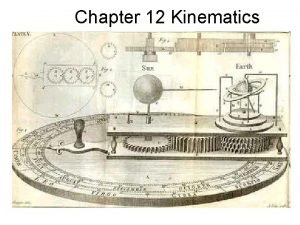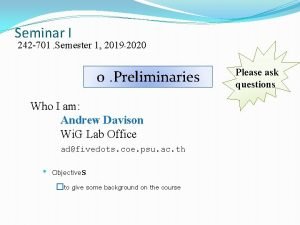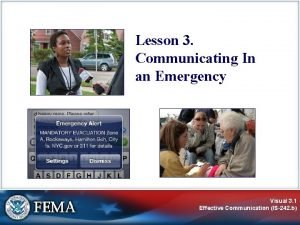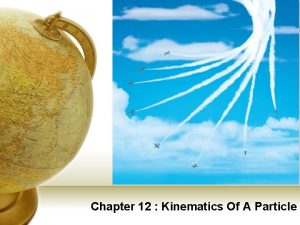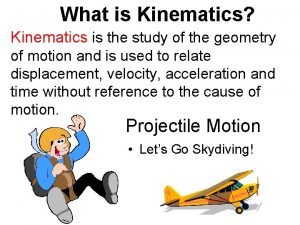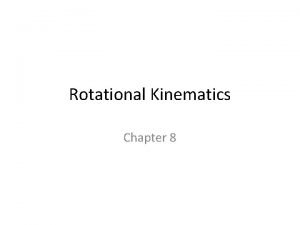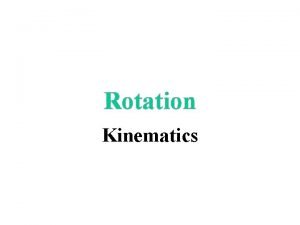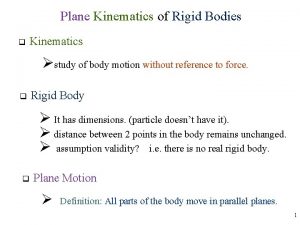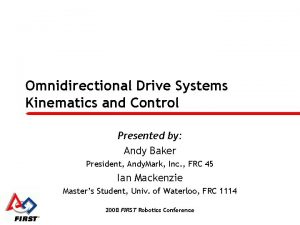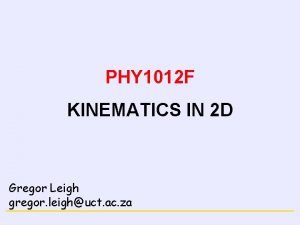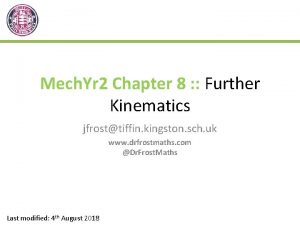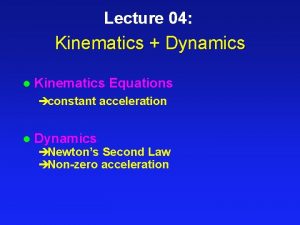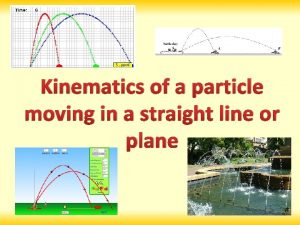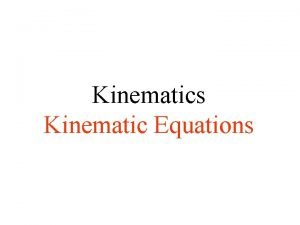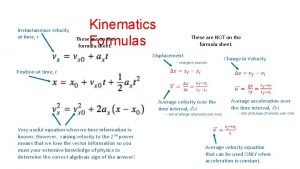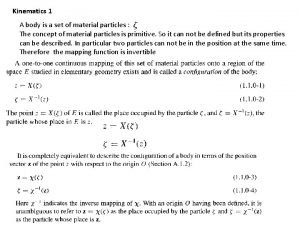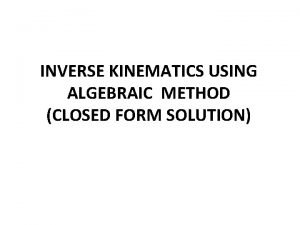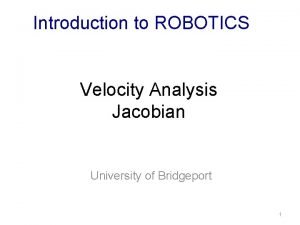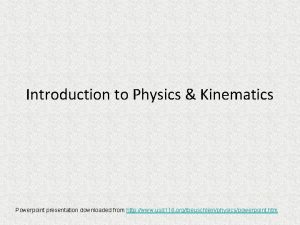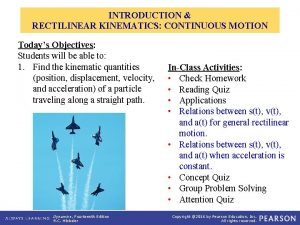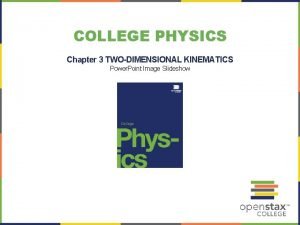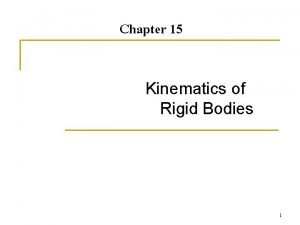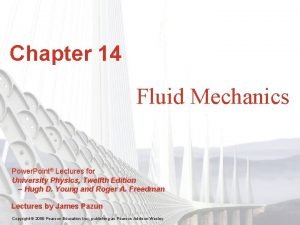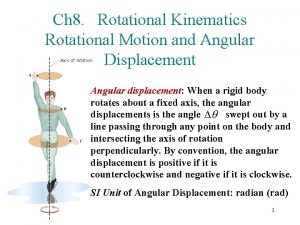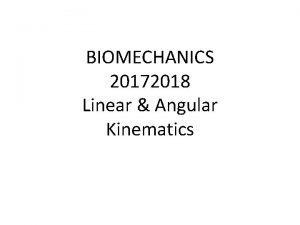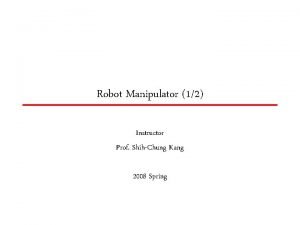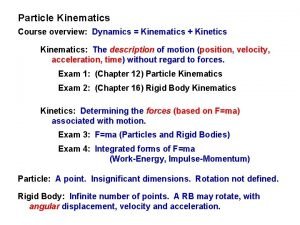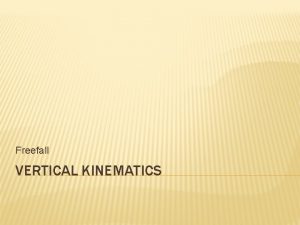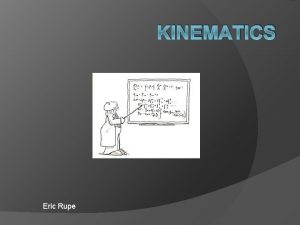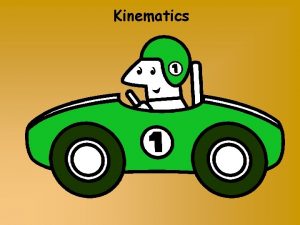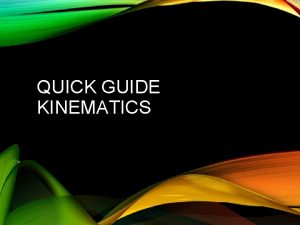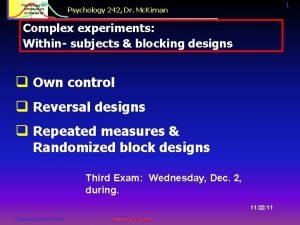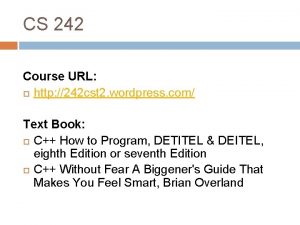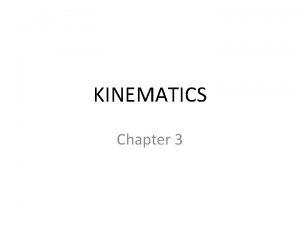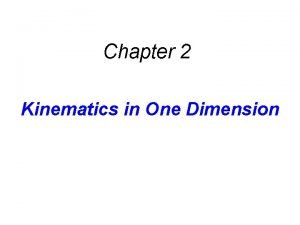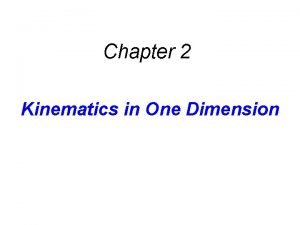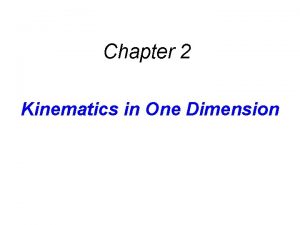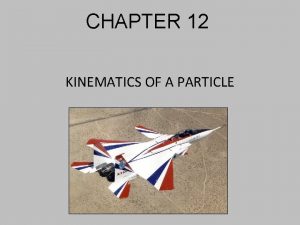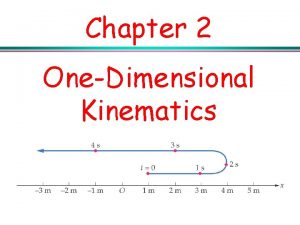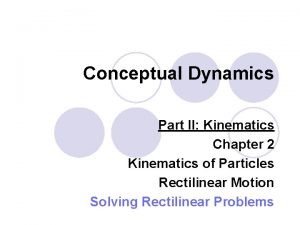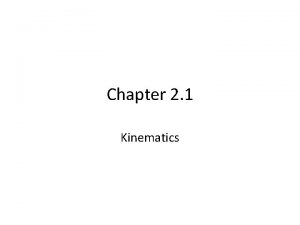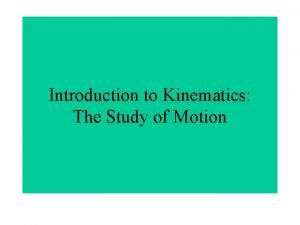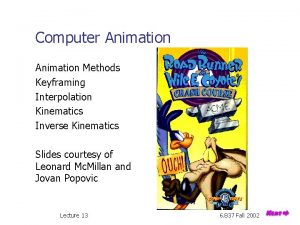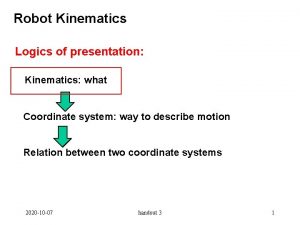Chapter 12 Kinematics ME 242 Chapter 12 Question





















































- Slides: 53

Chapter 12 Kinematics

ME 242 Chapter 12 Question 1 We obtain the acceleration fastest (A)By taking the derivative of x(t) (B)By Integrating x(t) twice (C)By integrating the accel as function of displacement (D)By computing the time to liftoff, then choosing the accel such that the velocity is 160 mph


ME 242 Chapter 12 160 mi/h = 235 ft/s Question 2 The acceleration is approximately (A)92 ft/s 2 (B)66 ft/s 2 (C)85. 3 ft/s 2 (D)182 ft/s 2 (E)18. 75 ft/s 2 Ya pili

ME 242 Chapter 12 Solution: 160 mi/h = 235 ft/s We use v*dv = a*dx 1/ v 2 = a*d, Integrate: 2 Question 2 The acceleration is approximately where d is the length of the runway, and the 2 (A)92 ft/s start velocity = 0 (B)66 ft/s 2 (C)85. 3 ft/s 2 (D)182 ft/s 2 (E) 18. 75 ft/s 2 Ya kwanza

Question 3 Road map: We obtain the velocity fastest (A)By Taking the derivative of a(t) (B)By Integrating a(t) (C)By integrating the accel as function of displacement (D)By computing the time to bottom, then computing the velocity.


ME 242 Tutoring • Graduate Assistant Ms. Yang Liu will be available to assist with homework preparation and answer questions. • Coordination through the Academic Success Center in TBE-A 207 Tuesday and Friday mornings. • Contact hours: MW after class

ME 242 Reading Assignments • Look up the next Homework assignment on Mastering • Example: your second assignment covers sections 12. 5 and 12. 6 • Study the text and practice the examples in the book • An I-Clicker reading test on each chapter section will be given at the start of each lecture • More time for discussion and examples

Supplemental Instruction ME 242 • Questions – Yang Liu – Ph. D student in ME – yangliu 205@gmail. com – Lab: SEB 4261

Chapter 12 -5 Curvilinear Motion X-Y Coordinates


Here is the solution in Mathcad

Example: Hit target at Position (360’, -80’)

Example: Hit target at Position (360, -80)

NORMAL AND TANGENTIAL COMPONENTS (Section 12. 7) When a particle moves along a curved path, it is sometimes convenient to describe its motion using coordinates other than Cartesian. When the path of motion is known, normal (n) and tangential (t) coordinates are often used. In the n-t coordinate system, the origin is located on the particle (the origin moves with the particle). The t-axis is tangent to the path (curve) at the instant considered, positive in the direction of the particle’s motion. The n-axis is perpendicular to the t-axis with the positive direction toward the center of curvature of the curve.

NORMAL AND TANGENTIAL COMPONENTS (continued) The positive n and t directions are defined by the unit vectors un and ut, respectively. The center of curvature, O’, always lies on the concave side of the curve. The radius of curvature, r, is defined as the perpendicular distance from the curve to the center of curvature at that point. The position of the particle at any instant is defined by the distance, s, along the curve from a fixed reference point.

ACCELERATION IN THE n-t COORDINATE SYSTEM Acceleration is the time rate of change of velocity: . . a = dv/dt = d(vut)/dt = vut + vut. Here v represents the change in. the magnitude of velocity and ut represents the rate of change in the direction of ut. After mathematical manipulation, the acceleration vector can be expressed as: . a = v ut + (v 2/r) un = at ut + an un.

ACCELERATION IN THE n-t COORDINATE SYSTEM (continued) So, there are two components to the acceleration vector: a = a t ut + a n un • The tangential component is tangent to the curve and in the direction of increasing or decreasing velocity. . at = v or at ds = v dv • The normal or centripetal component is always directed toward the center of curvature of the curve. an = v 2/r • The magnitude of the acceleration vector is a = [(at)2 + (an)2]0. 5

NORMAL AND TANGENTIAL COMPONENTS (Section 12. 7) When a particle moves along a curved path, it is sometimes convenient to describe its motion using coordinates other than Cartesian. When the path of motion is known, normal (n) and tangential (t) coordinates are often used. In the n-t coordinate system, the origin is located on the particle (the origin moves with the particle). The t-axis is tangent to the path (curve) at the instant considered, positive in the direction of the particle’s motion. The n-axis is perpendicular to the t-axis with the positive direction toward the center of curvature of the curve.

Normal and Tangential Coordinates Velocity Page 53

Normal and Tangential Coordinates ‘e’ denotes unit vector (‘u’ in Hibbeler)

‘e’ denotes unit vector (‘u’ in Hibbeler)

Learning Techniques • Complete Every Homework • Team with fellow students • Study the Examples • Ask: Ms. Yang, peers, me • Mathcad provides structure and numerically correct results

Course Concepts • Math • Think Conceptually • Map your approach BEFORE starting work

12. 8 Polar coordinates

Polar coordinates ‘e’ denotes unit vector (‘u’ in Hibbeler)

Polar coordinates ‘e’ denotes unit vector (‘u’ in Hibbeler)




12. 10 Relative (Constrained) Motion v. A is given as shown. Find v. B Approach: Use rel. Velocity: v. B = v. A +v. B/A (transl. + rot. )

Vectors and Geometry r(t) y q q(t) x

12. 10 Relative (Constrained) Motion V_truck = 60 V_car = 65 Make a sketch: A V_rel v_Truck B The rel. velocity is: V_Car/Truck = v_Car -v. Truck

Example Vector equation: Sailboat tacking at 50 deg. against Northern Wind (blue vector) We solve Graphically (Vector Addition)

Example Vector equation: Sailboat tacking at 50 deg. against Northern Wind An observer on land (fixed Cartesian Reference) sees Vwind and v. Boat. Land

12. 10 Relative (Constrained) Motion Plane Vector Addition is two-dimensional. v. A v. B/A

Example cont’d: Sailboat tacking against Northern Wind 500 150 i 2. Vector equation (1 scalar eqn. each in i- and j-direction). Solve using the given data (Vector Lengths and orientations) and Trigonometry

Chapter 12. 10 Relative Motion

Vector Addition

Differentiating gives:


Exam 1 • We will focus on Conceptual Solutions. Numbers are secondary. • Train the General Method • Topics: All covered sections of Chapter 12 • Practice: Train yourself to solve all Problems in Chapter 12

Exam 1 Preparation: Start now! Cramming won’t work. Questions: Discuss with your peers. Ask me. The exam will MEASURE your knowledge and give you objective feedback.

Exam 1 Preparation: Practice: Step 1: Describe Problem Mathematically Step 2: Calculus and Algebraic Equation Solving

And here a few visual observations about contemporary forms of socializing, sent to me by a colleague at the Air Force Academy. Enjoy!

Having coffee with friends.

A day at the beach.

Cheering on your team.

Out on an intimate date.

Having a conversation with your BFF

A visit to the museum

Enjoying the sights
 Aplusphysics kinematics-horizontal kinematics
Aplusphysics kinematics-horizontal kinematics Costas question
Costas question Kj242
Kj242 Gezang 239
Gezang 239 49 cfr 242
49 cfr 242 Que eterna gloria vou no ceu
Que eterna gloria vou no ceu He 242
He 242 Csc 242
Csc 242 Et 242
Et 242 Algol typing discipline
Algol typing discipline Manulife vip room withdrawal
Manulife vip room withdrawal Sxvisi svili
Sxvisi svili Step ap 242
Step ap 242 Et 242
Et 242 Schema 242
Schema 242 Hibbeler
Hibbeler I^242
I^242 Is-242.b
Is-242.b Series parallel resonance
Series parallel resonance Kinematics of a particle
Kinematics of a particle Question without question words
Question without question words Clearinghouse probe
Clearinghouse probe Contoh open-ended question adalah
Contoh open-ended question adalah Factors
Factors Direct indirect questions
Direct indirect questions Example of compelling question
Example of compelling question Compelling question definition
Compelling question definition Tricycle kinematics
Tricycle kinematics What is kinematics
What is kinematics Sin 37
Sin 37 4 linear motion equations
4 linear motion equations Linear kinematic equations
Linear kinematic equations Iczv
Iczv Swerve drive kinematics
Swerve drive kinematics Laws of kinematics
Laws of kinematics Dr frost further kinematics
Dr frost further kinematics Dynamics vs kinematics
Dynamics vs kinematics Kinematics of a particle
Kinematics of a particle Kinematic equations
Kinematic equations Instantaneous velocity formula
Instantaneous velocity formula Transport theorem kinematics
Transport theorem kinematics Inverse kinematics algebraic method
Inverse kinematics algebraic method Jacobian singularity
Jacobian singularity Kinematics powerpoint
Kinematics powerpoint Rectilinear kinematics
Rectilinear kinematics Rectilinear kinematics: continuous motion
Rectilinear kinematics: continuous motion Define fluid kinematics
Define fluid kinematics Kinematics ppt
Kinematics ppt Coriolis acceleration kinematics
Coriolis acceleration kinematics Kinematics of rigid bodies problems and solutions
Kinematics of rigid bodies problems and solutions Fluid kinematics - ppt
Fluid kinematics - ppt Unit of angular acceleration
Unit of angular acceleration Linear and angular kinematics
Linear and angular kinematics Forward kinematics
Forward kinematics




